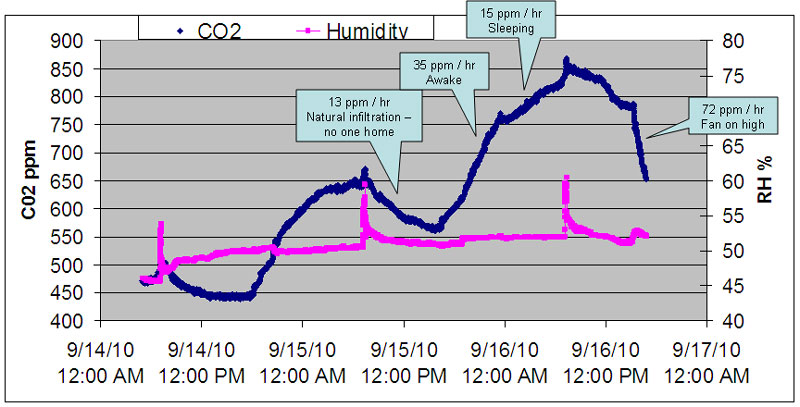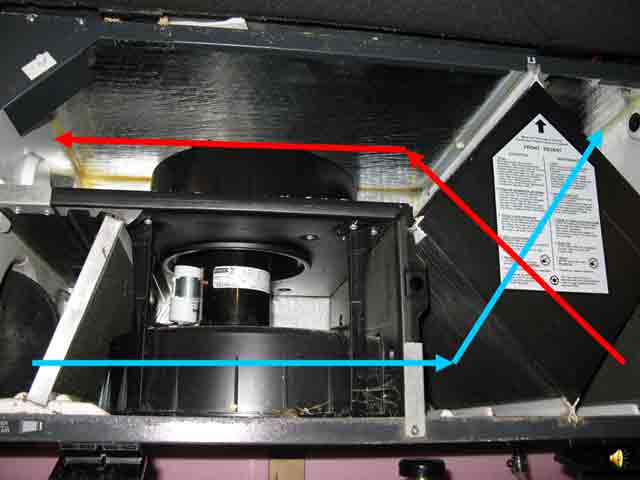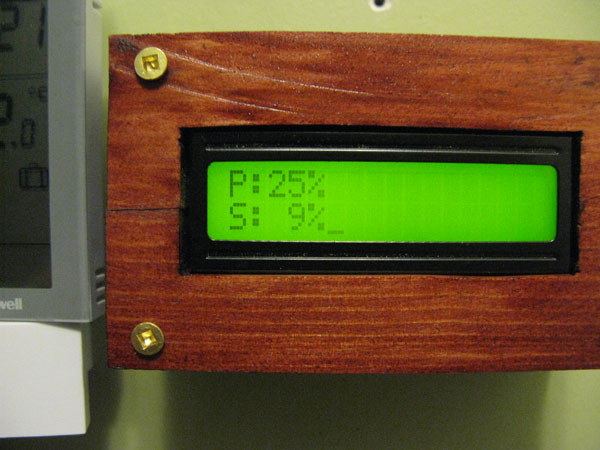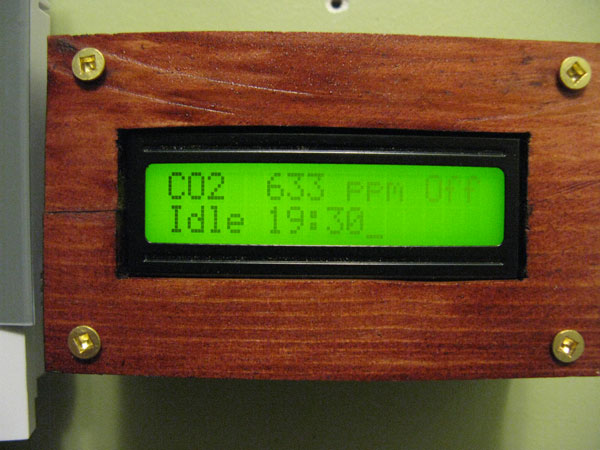- Home
- Deceptions
- Solar
- Thermal Audit
- Ventilation
- Sensors
- Governance
- Environment
- Reference
- Contact
- News
Ventilation on Demand
How to use a Ventilation system effectively and why the controls that came with your unit are useless.
I had previously written here about indoor air quality and ventilation requirement rules of thumb. These are generalities like how many times an hour the air in your home should be exchanged (ACH) such that you have decent indoor air quality. The idea was to size your ventilation system to be able to meet these targets -- but as it turns out, the whole exercise is misguided.
We will now take a more fundamental look at the problem.
CO2 (carbon dioxide)
Human activity generates carbon dioxide (you breath it out) and this raises the levels above what you find outdoors. The level outside is about 400 ppm (parts per million) and once you enter your house, you start adding to these levels. A classroom with the door closed in school is about 1000 ppm when people start yawning and the point when many would say it is stuffy inside.
Oxygen levels also drop, but this is negligible because there is already lots of oxygen in the atmosphere. At 20% or about 1/5 of your living room full of oxygen, you are not going to notice a reduction in oxygen that makes you feel like you are on a mountain top somewhere. By contrast, CO2 levels start out at .0039% and are very tightly connected to your body's biochemistry. If they rise, your breathing rate changes and you may feel tired.
Let's start by looking at the CO2 and humidity levels in a room during a typical day where you sleep at night, have a burst of activity and then leave the home vacant and go to work. You return at 6pm and go to bed close to midnight.

Note the following:
- The rate that the CO2 levels goes up is approximately double during the day as it is at night. This is because you aren't exerting yourself much at night and burn less energy. You burn sugar and fats and make carbon dioxide just as your car produces CO2 by burning gasoline.
- Rates fall off quite rapidly when you leave the house because of natural infiltration (drafts). They fall off even faster if the ventilation fan is on or it is windy outside.
- Humidity is totally useless as an indicator that someone is home. You may get spikes during a morning shower as in the graph above, but unless you are boiling water for hours, it doesn't change much throughout the day. Humidity is the red line in the graph above and one of the intakes for the ventilation is a foot from a shower stall.
There are many other pollutants that can lower the indoor air quality, but almost all of them are associated with humans being in the house. Smoking and cooking are obvious examples. If you can keep the C02 levels under control, you will likely keep everything else under control too. Of all the things you can test for, humidity is one of the most useless but unfortunately, that is exactly what the controls on a Venmar heat exchanger do.

Notice that there is a setting for Summer, assuming it will be more humid then so raising the set point will prevent it being on all the time. No matter what you set it at, it will either be on or off almost all the time since humidity levels don't change rapidly. If you look at the red line in the graph above, where would you have set humidity control to turn on and off? (no good answer here). In other words, it is useless.
I previously suggested using a timer to turn the fans on and off with a set rhythm -- two hours on and two hours off. This cuts your operating expenses in half, but is unfortunately still pretty dumb.
Natural air infiltration
Most houses have a lot of leaks and don't need extra ventilation on windy days or perhaps at all. The house tested for this article had been very well sealed, for example:
- The dryer vent was replaced with a non draft ball vent.
- All plastic vapor barriers were glued together with acoustic sealant (a soft tar like black goo)
- All pot lights were made air tight with plastic and expanding foam
- One way air flaps were added to every bathroom fan
- Door seals were touched up with silicone so that there were zero drafts
- All wall sockets were sealed, some with special plastic boxes that seal the incoming wires.
So, given that this is far tighter than your average home, was the air infiltration very significant? Well, it all depends on the wind. When the winds are high (say 50 kmh and above, which is a typical city speed limit) the CO2 levels don't even rise. When there is no wind at all, it gets stuffy rapidly. If you get your house tested with a blower door, they decrease the pressure by 50 Pascals (not enough to pop your eardrums) and look for drafts. A windy day does the same thing.
The graph below shows that on a really windy period, you don't need extra ventilation to keep the CO2 levels low. On a day with no wind and lots of activity in the house, it can't keep up. You could have a larger ventilation unit to solve this, but then it would be even more important for it to be intelligent enough to know when not to be on.

To verify this, the Davis Vantage Pro weather station on the solar collector was used to overlay the C02 and humidity readings, and this was the result:

The colors have changed. Red is the high wind gusts so you can see this is a ridiculously windy place (Canadian North Atlantic). The lower dark blue link is the average wind speed, and the yellow is the CO2 level in parts per million. The period in brackets spanning about two days did not need extra ventilation and it isn't surprising given the red (wind gusts) were hovering around 40 kmh. The controller was programmed to come on if the levels exceeded 750 ppm but this never happened.

The graph above shows that the wind finally stopped and the CO2 levels began to rise, and at the right bracket, the fan was finally triggered. The spike immediately after was due to some intense activities. If you start lifting heavy boxes or working out, you will find the levels go up very rapidly. Using a car as an example, exhaust at idle or a human sitting watching TV is nothing compared to driving at highway speeds or running on a treadmill.
There are a few ways we can keep the air quality decent and not waste too much expensive heat or cooling by having the fan run when it is useless. Since using the humidity control is useless and using a timer will save money but has no idea if it really ought to be on or not, we are left with:
- Turn the unit on when it feels stuffy (instead of opening a window like you would have years ago). In this case, you are the carbon dioxide sensor.
- Write a small program using a cheap remote control device like the X10 and its "firecracker" adapter to poll yahoo for the weather results and turn the ventilation on when wind levels are low, and also turn it off during periods when you are never home (e.g. single person that works 9-5).
- Actually measure the gasses in the return air duct and make intelligent decisions based on reality.
To experiment with the 3rd, option, the following was set up:
Gas sensors were installed in the incoming and outgoing heat exchanger ports since this is the place where you can make an intelligent decision about whether it should be on or off.
The diagram below shows the basic layout of a heat exchanger. Warm air leaving (red arrow) passes through the diamond shaped block and warms the air coming in. This heat exchange and the ability to run the air through a filter is the whole reason behind using an $800+ ventilation system instead of opening your windows for free. The latter is often a good idea, especially when the temperature outside is pleasant.

Then using a micro controller like you might have in your microwave oven, a control program was set up to do the following:
- Sample the air for 2 minutes and record various gas concentrations (CO2 is the important one), temperature and humidity. I've yet to detect propane, methane or natural gas in this house.
- Keep it on for 2 minutes and then if the levels exceed 750 ppm, keep the fan on high until the levels drop back down to 700 ppm.
- Once levels are back down to 700 ppm, stay off for 30 minutes, and then sample again for 2 minutes to see what changed.

The final results are very interesting. The screen above shows the percentage of time that has been used for sampling and for purging stale air. Over the last week, the average has been:
- 9% sampling (which is just the cost of sampling)
- 25% purging (when it needs to be on)
- The remaining 66% of the time it was off because it wasn't needed.
Obviously if you used a timer to turn it on 25% of the time you would exhaust the right quantity of air, but there is no way it would be timed right. Furthermore, without the controller, I would never have known that 25% was what I needed on average this January, either. This of course is the whole problem with rules-of-thumb and sizing units based on the suggested number of air exchanges per hour. There are too many variables, so unless you have some way of measuring the pollutants in the air, you are just taking a wild guess.

This picture above is showing that the current C02 level is 633 ppm (not enough to feel stuffy) and the fan is Off. The system has been idle for 19 minutes and 30 seconds and will soon turn on the fan for another sampling period.

This photo above shows the real value of a heat exchanger. The air going out is 23.8°C with 30.7% humidity (room temperature) but the incoming air is already 16.9°C despite being -3°C outside (just below freezing with 75% humidity). The outgoing air is warm and releases heat from condensation when it cools in the heat exchanger core. If this was a ventilation system without the heat exchanger core, the incoming air would be a frigid -3°C instead of almost room temperature.
There is also a lot more that can be done with on-demand ventilation such as:
- Making a proper PID controller for it (e.g. control theory instead of on at 750 and off at 700ppm) and letting it control the motor speed. There are algorithms to minimize the operation costs or maximize rapid performance.
- Turning the fan on to cool the house after a hot summer day when it cools down after sunset or after a thunderstorm.
- Adusting the humidity levels when possible (based on the difference between the inside and outside humidity) to reduce the possiblity of mold growth. This is more of a comfort feature than saving money, although reducing humidity could save you from mold damage.
- Monitoring dust as well as CO2 by counting dust particles by adding a real-time dust particle counter. (cheap ones don't exist so I will have to build one from scratch)
- Going bizzerk when explosive levels of propane/natural gas or poisonous carbon monoxide are detected (fan high and alarm sounding).
- Identifying the food being cooked and your guests by their odors and making voice comments (just kidding - although the technology is rapidly getting to that point (missing link to IEEE article)
It is a shame that millions of homes are stuck with brainless HRV units with failing motors leaving everyone with variable air quality and excessive utility bills. A fan motor draws about 200 watts and at 24 hours a day, this is 1725 kWh per year or about $175 in North America. The potential savings here would have been 66% or $115 a year, just for running the motor. The savings from the heat exchange part could also be significant if you live in a very cold climate and use electric heat. The health considerations around indoor air quality have some value too, but it would be impossible to quantify but potentially significant if you have smokers and non-smokers in the same household or have breathing problems.
All the data is now streaming into a SQL database and I'll do some crunching later once I have all four seasons to analyze.
